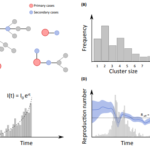Lien vers Pubmed [PMID] – 20042753
N. Engl. J. Med. 2009 Dec;361(27):2619-27
BACKGROUND: As of June 11, 2009, a total of 17,855 probable or confirmed cases of 2009 pandemic influenza A (H1N1) had been reported in the United States. Risk factors for transmission remain largely uncharacterized. We characterize the risk factors and describe the transmission of the virus within households.
METHODS: Probable and confirmed cases of infection with the 2009 H1N1 virus in the United States were reported to the Centers for Disease Control and Prevention with the use of a standardized case form. We investigated transmission of infection in 216 households–including 216 index patients and their 600 household contacts–in which the index patient was the first case patient and complete information on symptoms and age was available for all household members.
RESULTS: An acute respiratory illness developed in 78 of 600 household contacts (13%). In 156 households (72% of the 216 households), an acute respiratory illness developed in none of the household contacts; in 46 households (21%), illness developed in one contact; and in 14 households (6%), illness developed in more than one contact. The proportion of household contacts in whom acute respiratory illness developed decreased with the size of the household, from 28% in two-member households to 9% in six-member households. Household contacts 18 years of age or younger were twice as susceptible as those 19 to 50 years of age (relative susceptibility, 1.96; Bayesian 95% credible interval, 1.05 to 3.78; P=0.005), and household contacts older than 50 years of age were less susceptible than those who were 19 to 50 years of age (relative susceptibility, 0.17; 95% credible interval, 0.02 to 0.92; P=0.03). Infectivity did not vary with age. The mean time between the onset of symptoms in a case patient and the onset of symptoms in the household contacts infected by that patient was 2.6 days (95% credible interval, 2.2 to 3.5).
CONCLUSIONS: The transmissibility of the 2009 H1N1 influenza virus in households is lower than that seen in past pandemics. Most transmissions occur soon before or after the onset of symptoms in a case patient.


